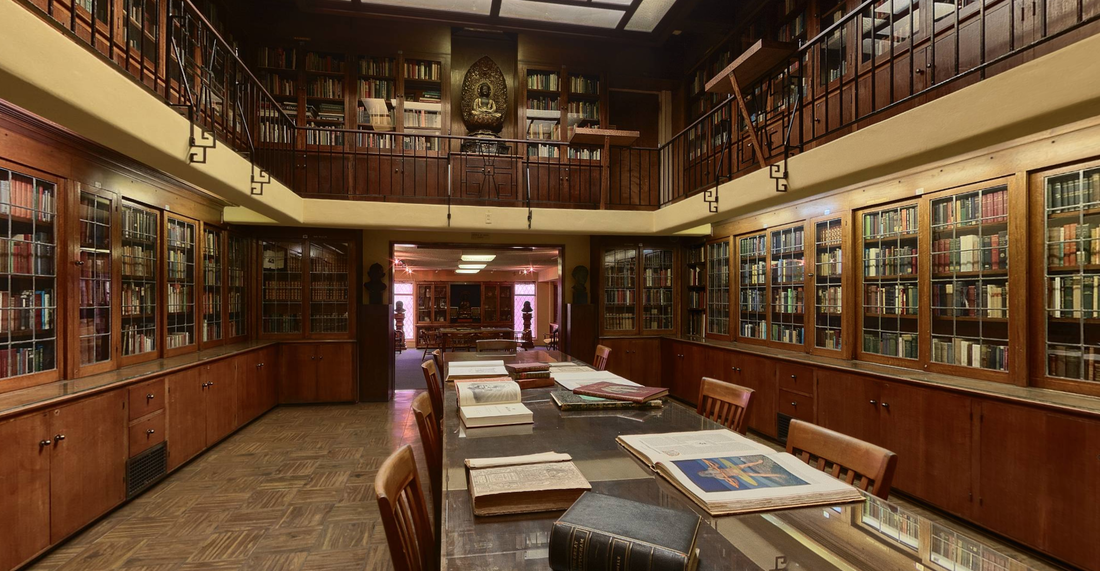The Philosophical Research Society Library
Library Hours
- Thursdays & Fridays: Open to the Public 12-6pm
Online Library Resources
PRS Vintage Journals from Manly P. Hall's Tenure: The All-Seeing Eye | Horizon | PRS Journal
Browse the famed alchemical manuscript collection of Manly Palmer Hall at the Getty Research Institute
The Complete Online Catalogue of over 25,000 titles is made possible by the Virginia S. Warner Foundation.
PRS wants all guests to be able to enjoy our library safely and comfortably. If you require any accessibility accommodation, please reach out to [email protected] or phone 323-663-2167 and we will be happy to assist you.
About the PRS Library
In 1934, PRS was incorporated as a nonprofit educational institution. Shortly thereafter, the corporation was able to secure the property on which its library and other buildings now stand. On October 17, 1935, nearly one hundred people assembled on the site for the purpose of breaking ground for the headquarters, which included a front office, print shop, bindery, and library.
The architectural theme for the buildings derives its inspiration from the early culture of the ancient Mayans. Renowned architect Robert Stacy-Judd was commissioned to design the initial buildings. Stacy-Judd also published several popular books on Mayan culture which are part of our collection. He sought to incorporate Mayan symbols and design motifs throughout the buildings.
Prior to the construction of the library, PRS founder Manly P. Hall had been writing, lecturing and attracting the attention of wisdom seekers from across the country. Generous donations from philanthropists and supporters enabled Mr. Hall to visit great auction houses of Europe to purchase rare manuscripts and sourcebooks printed prior to 1800, which added to the growing collection of the wisdom library. It is a collection so impressive that during World War II, The Library of Congress requested permission to make microfilm copies of unique items for permanent record, in case the library should be damaged by bombardment.
The library collection grew book by book, building on the great truths of illuminated thinkers such as Pythagoras, Plato, Buddha, Confucius, Hermes, Aristotle, Jesus and Mohammed; along with other prophets and sages. The emphasis of the collection has always been upon those idealistic systems of knowledge which have helped to build a better world. The whole purpose of this collection is to meet society’s increasing awareness of the need for an internal philosophy. Here the great seers, sages, scholars, and mystics are made available through their own writings, and need not be approached only through books of modern interpreters. The bulk of the collection focuses on Philosophy, Psychology, Mythology, Anthropology, Religion and World Cultures.
It always seemed to Manly P. Hall that religious and symbolic art should be included in a collection representing society’s heritage of wisdom and beauty. Over the years, many art objects were acquired and are on permanent display on campus. A few visible items of special interest to library visitors:
The architectural theme for the buildings derives its inspiration from the early culture of the ancient Mayans. Renowned architect Robert Stacy-Judd was commissioned to design the initial buildings. Stacy-Judd also published several popular books on Mayan culture which are part of our collection. He sought to incorporate Mayan symbols and design motifs throughout the buildings.
Prior to the construction of the library, PRS founder Manly P. Hall had been writing, lecturing and attracting the attention of wisdom seekers from across the country. Generous donations from philanthropists and supporters enabled Mr. Hall to visit great auction houses of Europe to purchase rare manuscripts and sourcebooks printed prior to 1800, which added to the growing collection of the wisdom library. It is a collection so impressive that during World War II, The Library of Congress requested permission to make microfilm copies of unique items for permanent record, in case the library should be damaged by bombardment.
The library collection grew book by book, building on the great truths of illuminated thinkers such as Pythagoras, Plato, Buddha, Confucius, Hermes, Aristotle, Jesus and Mohammed; along with other prophets and sages. The emphasis of the collection has always been upon those idealistic systems of knowledge which have helped to build a better world. The whole purpose of this collection is to meet society’s increasing awareness of the need for an internal philosophy. Here the great seers, sages, scholars, and mystics are made available through their own writings, and need not be approached only through books of modern interpreters. The bulk of the collection focuses on Philosophy, Psychology, Mythology, Anthropology, Religion and World Cultures.
It always seemed to Manly P. Hall that religious and symbolic art should be included in a collection representing society’s heritage of wisdom and beauty. Over the years, many art objects were acquired and are on permanent display on campus. A few visible items of special interest to library visitors:
- Glastonbury Tiles: As one crosses the patio toward the entrance to the library, visitors may notice two small fragments of decorated tile inlaid among the flagstones. These should be approached with respect as they are original pieces from the floor of Glastonbury Abbey. It is within the precincts of Glastonbury that a sacred thorn bush still flourishes near the reputed grave of King Arthur.
- Library Doors: The beautiful wood panels on the library doors were carved by Stuart Holmes (who played the villain in the 1922 motion picture production The Prisoner of Zenda). Stuart was a Bavarian whose real name was Stuart Leibchen; he was a wood-carver of distinction. The panel on the left is reminiscent of Confucius, and its Western complement on the right is suggestive of Plato.
- Coatlicue: On the right as one enters the library is a large Aztec wood-carving representing Coatlicue, Mother of the Gods, known as “Lady of the Serpent Skirt,” based upon the gigantic stone figure in the Museo Nacional de Antropologia in Mexico City. The original stone image is over 8 feet high and weighs over 30 tons. This zapote wood carving, created by a Mexican folk artist, is extremely hard and heavy, and will sink if placed in water.
- Amida Buddha: In a niche on the south wall of the balcony of the library is a fine Japanese wood carving of the metaphysical Buddha, Amida. This lovely gilded image is approximately 4½ feet high. It had already been consecrated, and fitted perfectly into the allotted space and its peaceful expression is suitable for quiet scholarship. There is an elaborate base with a symbolic lotus upon which the figure is seated, and behind is an intricately decorated nimbus of swirling clouds. It is dated in the Tokugawa Period, probably late seventeenth century.

